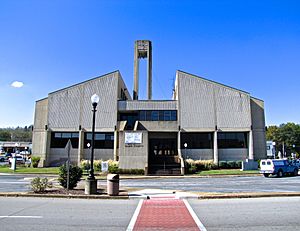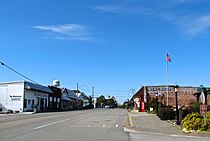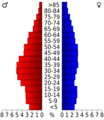Wayne County, Tennessee facts for kids
Quick facts for kids
Wayne County
|
|
|---|---|

Wayne County Courthouse in Waynesboro
|
|

Location within the U.S. state of Tennessee
|
|
 Tennessee's location within the U.S. |
|
| Country | |
| State | |
| Founded | 1817 |
| Named for | General Anthony Wayne |
| Seat | Waynesboro |
| Largest city | Clifton |
| Area | |
| • Total | 736 sq mi (1,910 km2) |
| • Land | 734 sq mi (1,900 km2) |
| • Water | 1.6 sq mi (4 km2) 0.2%% |
| Population
(2020)
|
|
| • Total | 16,232 |
| • Density | 22/sq mi (8/km2) |
| Time zone | UTC−6 (Central) |
| • Summer (DST) | UTC−5 (CDT) |
| Congressional district | 7th |
Wayne County is a place in south central Tennessee, right next to the Alabama border. In 2020, about 16,232 people lived here. The main town, or county seat, is Waynesboro. The county got its name from General "Mad Anthony" Wayne. He was a very important military leader during the American Revolutionary War.
Contents
History of Wayne County
Wayne County was created in 1817. It was formed from parts of Hickman and Humphreys counties. Waynesboro, the county's main town, was started in 1821. The city of Clifton became an important river port in the mid-1800s. It is located along the Tennessee River.
During the American Civil War, Wayne County had a special role. Many people in this area supported the Union. This was different from most of West and Middle Tennessee, which supported the Confederacy. On June 8, 1861, people in Wayne County voted to stay with the Union. The vote was 905 to 409. Wayne was one of only eight counties in West or Middle Tennessee to vote for the Union.
Geography of Wayne County
Wayne County covers about 736 square miles. Most of this area is land, with only a small part being water. It is the second-largest county in Tennessee by size. The county is mostly located in the southwestern Highland Rim area. The Tennessee River flows along the county's northwestern edge. The Buffalo River also flows through the northern part of Wayne County. It is a branch of the Duck River. The Green River, which flows into the Buffalo, goes through Waynesboro.
Neighboring Counties
- Perry County (north)
- Lewis County (northeast)
- Lawrence County (east)
- Lauderdale County, Alabama (south)
- Hardin County (west)
- Decatur County (northwest)
National Protected Areas
- Natchez Trace Parkway (part)
State Protected Areas
- Arnold Hollow Wildlife Management Area
- Browntown Wildlife Management Area
- Eagle Creek Wildlife Management Area
- Tie Camp Wildlife Management Area
People of Wayne County
The number of people living in Wayne County changes over time. In 2020, there were 16,232 people. There were 5,764 households and 4,016 families.
2020 Census Information
| Group | Number | Percentage |
|---|---|---|
| White (not Hispanic) | 14,503 | 89.35% |
| Black or African American (not Hispanic) | 878 | 5.41% |
| Native American | 18 | 0.11% |
| Asian | 27 | 0.17% |
| Pacific Islander | 1 | 0.01% |
| Other/Mixed | 426 | 2.62% |
| Hispanic or Latino | 379 | 2.33% |
Religious Groups
Many different religious groups are found in Wayne County. Most people are Christian. Here are some of the main groups:
- Southern Baptist Convention (47%)
- United Methodist Church (15%)
- Independent Free Will Baptist Associations (13%)
- Churches of Christ (12%)
- Church of God (5%)
- National Association of Free Will Baptists (3%)
- Cumberland Presbyterian Church (2%)
- Presbyterian Church (1%)
- International Pentecostal Holiness Church (1%)
- Catholic Church (1%)
- Church of God of Prophecy (0.8%)
- Christian Church (Disciples of Christ) (0.6%)
- Seventh-day Adventist Church (0.3%)
- Church of the Nazarene (0.1%)
- Other Christian groups (15%)
- Baháʼí (0.1%)
Education in Wayne County
Wayne County has several schools and a college.
College
- Columbia State Community College in Clifton
Public Schools
- Wayne County Adult Education Center
- Frank Hughes School
- Waynesboro Elementary School
- Waynesboro Middle School
- Wayne County High School
- Wayne County Technology Center
- Collinwood High School
- Collinwood Middle School
- Collinwood Elementary School
Media in Wayne County
You can find local news and radio stations here.
Radio Stations
- AM 930 WWON Waynesboro, Tennessee
- FM 94.9 WMSR-FM Collinwood, Tennessee
- FM 106.5 WLVS-FM Clifton, Tennessee
- FM 89.9 W210BE Waynesboro, Tennessee
- FM 100.7 WWON-FM Waynesboro, Tennessee
Newspaper
- The Wayne County News
Events in Wayne County
Wayne County hosts many fun events throughout the year.
- Singing on the Farm – Cypress Inn
- Tour De Wayne Bicycle Ride
- Fireworks Show – Waynesboro
- Fourth of July in the Park – Waynesboro
- Wayne County History and Craft Fair – Waynesboro
- Old Timer's Day – Collinwood
- Horseshoe Riverbend Festival – Clifton
Communities in Wayne County
Wayne County has several cities and smaller communities.
Cities
- Clifton
- Collinwood
- Waynesboro (county seat)
Unincorporated Communities
These are smaller towns and areas without their own city government.
Notable Individuals
Some important people have come from Wayne County.
- Lon A. Scott – He was a member of the United States House of Representatives for Tennessee.
- Thetus W. Sims – He was also a politician and a member of the United States House of Representatives for Tennessee.
Images for kids
See also
 In Spanish: Condado de Wayne (Tennessee) para niños
In Spanish: Condado de Wayne (Tennessee) para niños



